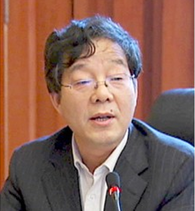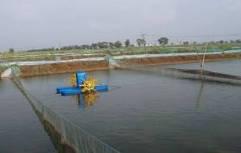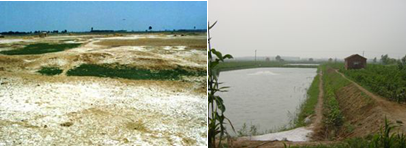 Shuanglin Dong
Shuanglin Dong
Professor, Laboratory of Aquaculture Ecology
Department of Aquaculture, Fisheries College
Vice President and Dean of Graduate School of Ocean University of China
5 Yushan Road, Phone: 86-532-82032435
Qingdao 266003, Fax: 86-532-82032435
P. R. China Email:dongsl@ouc.edu.cn
EDUCATION
BS, Agriculture, Dalian Fisheries University, 1982
PhD, Agriculture, Ocean University of Qingdao, 1992
RESEARCH
Research Interests:
My research focuses on aquaculture ecology, such as, optimal environment conditions for individual growth and response to environment factor variation of cultural organisms, the principle and techniques of water quality management, the structure and function of aquaculture ecosystems, the interaction between aquaculture and environment, and economic ecology in aquaculture.
Specific Research Directions:
1. Research and application of clean and efficient mariculture technology in seawater ponds
Since late 1980's, mariculture in ponds developed rapidly in China, however, the traditional model of high-density, monoculture in ponds led to significantly negative impacts on water environment due to low feed efficiency.Therefore, developing healthy mariculture models in seawater ponds, improving feed efficiency and reducing pollution have become country's prior demands.
During 1993-2008 based on basic research we developed and optimized integrated aquaculture models of shrimp, sea cucumber, fish and swimming crab in ponds, established the techniques of water pollution control and disease prevention ecologically, achieved the win-win benefits of economic and environmental efficiencies in order to provid key technology support for sustainable development of mariculture in ponds.
The main innovations of this project include: ⑴ methodologically developed land-based experimental enclosures, mesocosm system, overcame the defects of the distortion ofexperimental aquarium and uniformity of experimental ponds, lead the field experiment in pond to repeatable and testable. ⑵ Based on three strategies (Waste reclamation through trophic relationship between integrated species, Water quality maintenance through complementary functions between culture organisms or sub-systems, Making full use of the resources through different ecological niche species) built and optimized 17 integrated aquaculturestructures. For example, 1:1.3:8.3 structure of shrimp-green clam-Gracilariaresulted in shrimp production increasingby 18.5%, N utilization rate increasingby 48%, output/put ratio increasingby 39%. ⑶ Discovered that the resting eggs of zooplankton could carry and spread WSSV, invented the enclosed fence andcut off WSSV transmission paths to prevent shrimp disease ecologically.⑷ developed systematically water quality control techniques by filter feeding fish, bivalves and macroalgae, inventednet-isolated polyculture of tilapia and shrimp, by which the shrimp production improvedsignificantly. These technologies have been extended to many regions in China,obtained great economic, ecological and social benefits.This project gained the second prize for the National Science and Technology Advancement in 2012.

2. Studies and application of aquaculture technology in saline-alkaline ponds. There are more than 33 million hectares of saline-alkaline soil land in China, of which more than 6.7 million hectares are low-lying saline-alkaline soil land. Exploitation of this part of land resources is one of the national major demands. Some of the techniques are successful to exploit the low-lying saline-alkaline soil land, however, theireconomic results are less than ideal. Our laboratory has implemented the dike-pond terrace system and water control technology in order to reduce soil salinity and alkalinity of the terraceand to culture fishes in ponds successfully.
This technology developed in the project include mainly: implement the dike-pond terrace system, develop integrated technologies to control water quality, evaluate more than 10 kinds of cultured organisms on tolerance to salinity and alkalinity, optimize aquaculture structures and fresh-water saving techniques and so on. Application of these technologies improved soil quality and water quality significantly. The crop productionson terrace were more than 12,000kg/ha, and fish productions in ponds reached 7,500kg/ha, achieving a double harvest of agriculture and aquaculture. These technologies have been extended to 8 provinces in China,obtained great economic and social benefits.
This project gained the second prize for the National Science and Technology Advancement in 2006.

Research Projects (recent 10 years):
§ Habitat restoration technology and demonstration in typical artificial wetland, National High-tech R & D Program of China (863 Program, Grant No. 2002AA648010), 2002-2004
§ Research and development of aquaculture pollution control and clean production technology, National Key Technologies R & D Program of China during the 11th Five-Year Plan Period(Grant No. 2006BAD09A01), 2006-2010
§ Technologies and demonstration of clean production and environmental safety intypical waters, The National Special Program for Research on Marine Public Interest (Grant No. 200905020), 2009-2011
§ Research on the key technology of clean and efficiency mariculture in seawater ponds, National Key Technologies R & D Program of China during the 11th Five-Year Plan Period(Grant No. 2011BAD13B03), 2011-2015
Academic Positions and Awards:
§ 2005-2012, Vice president of the Fisheries Society of China
§ 2006-2013, Member of Agriculture and Forestry Board ofthe Science and Technology Commission ofthe Ministry of Education
§ 2004-present, Director of the Marine Economic Society of China
§ 2004-present, Associate Chairman of the Crustacean Board of the China Animal Association
§ 2004-present, Executive member of the Oceanolgy and Liminolgy Society of China
§ 2013-present, Vice Chairman of the Fisheries Specialty of theUniversity Teaching Guidance Committee of the Ministry of Education
§ 1997, Winner of National Science Fund for Distinguished Young Scholars
§ 1999, Winner of Special Allowances of the State Council
§ 2006 The second prize for the National Science and Technology Advancement: Studies and application of aquaculture technology in saline-alkaline ponds.
§ 2012 The second prize for the National Science and Technology Advancement: Research and application of clean and efficient mariculture technology in seawater ponds
PUBLICATION (recent 10 years)
Jin, Q., Dong, S.L., Nan, C.R., 2003. Comparative studies on the allelopathic effects of twodifferent strains of Ulva pertusa on Heterosigma akashiwoand Alexandrium tamarense, Journal of Experimental Marine Biology andEcology, 293(2003):41-55.
Zhao, W., Dong, S.L., 2003. The contribution of size-fractionated plankton to biomass and primary production of phytoplankton in saline-alkaline ponds. Hydrobiologia, 492: 181-190.
Nan, C.R., Dong, S.L., Jin, Q., 2003. Test of resource competition theory between microalgaand macroalga under phosphate limitation. Acta Botanica Sinica. 45(3): 282-288.
Wang, F., Dong, S.L., Huang, G.Q., Wu, L.X., Tian, X.L., 2003. The effect of light color on the growth of Chinese shrimp. Fenneropenaeus chinensis. Aquaculture, 228(1-4): 351-360.
Huang, G.Q., Dong, S.L., Wang, F., Ma, S., 2003. Selection and use of different diets in a study on Chinese shrimp, Fenneropenaeus chinensis. J. Shellfish Research, 22(1):547-553.
Wang, F., Dong, S.L, Huang G.Q., et al., 2003.The effect of light intensuty on the growth of Chinese shrimp Fenneropenaeus chinensis. Aquaculture,234(1-4): 475-483.
Zhu, C. B.,Dong, S. L., Wang, F., Huang, G. Q., 2004. Effects of Na/K ration in seawater on growth and energy budget of juvenile Litopenaeus vannamei. Aquaculture, 234(1-4): 485-496.
Yan, D. C.,Dong, S. L., Huang, J., Yu, X. M., Feng, M. Y., Liu, X. Y., 2004. White spot syndrome virus (WSSV) detected by PCR in rotifers and rotifer resting eggs from shrimp pond sediments. Diseases of Aquatic Organisms, 59:69-73.
Tian, X.L., Dong, S.L., Wang, F., 2004.The effects of temperature changes on the oxygen consumption of Chinese shrimp. Journal of Experimental Marine Biology and Ecology, 310(1): 59-72.
Huang, G. Q., Dong, S. L., Wang F., 2005. Effects of feeding level on the growth, energy budget, and body biochemical composition of Chinese shrimp Fenneropenaeus chinensis. Journal of Shellfish Research, Vol.23 ,No.3, 919-925.
Jin, Q., Dong, S.L., Wang, C.Y., 2005. Allelopathic growth inhibition of Prorocentrun micans (Dinophyta) by Ulva pertusaand Vlvalinza (Chlorophyta) in laboratory cultures.European Journal of Phycology, 40(1):31-37.
Huang, G. Q., Dong, S. L., Wang, F., 2005. Growth, energy allocation, and biochemical composition of the body of Chinese shrimp, Fenneropenaeus chinensis, fed different diet. Crustaceana, 78(2): 141-162.
Dong, Y. W., Dong, S. L., Tian, X. L., Wang, F., 2006. Effects of diel temperature fluctuations on growth, oxygen consumption and proximate body compositions of sea cucumber Apostichopus japnicus Skelenka. Aquaculture, 255:514-521.
Zhu, C. B.,Dong, S. L., Wang, F., Huang, G. Q., 2006.Interaction of salinity and Na/K ratio in seawater on growth,nutrient retention and foodconversion of juvenileLitopenaeus vannamei. J. Shellfish Research, 25 (1) : 107-112
Lui, H., Zhu, J. X., Sun, H. L., Fang, J. G., Gao, R. C. and Dong, S. L., 2006. The clam, Xishi tongue Coelomactra antiquata (Speng;er), a promising new candidate for aquaculture in China. Aquaculture, 255: 402-409.
Tian, X.L., Dong, S.L., 2006. The effects of thermal amplitude on the growth of Chinese shrimp Fenneropenaeus chinensis. Aquaculture, 251:516-524.
Chang-Bo Zhu, Shuang-Lin Dong, Fang Wang, Han-Hua Zhang, 2006. Effects of seawater potassium concentration on the dietary potassium requirement of Litopenaeus vannamei. Aquaculture, 258: 543-550.
Zhang, J. S., Dong, S. L., 2006. Studies on the rotifer (Brachionus urceus Linnaeus, 1758) as a vector in white spot syndrome virus (WSSV) transmission. Aquaculture, 261:1181-1185.
Dong, Y. W., Dong, S. L., 2006. Growth and oxygen consumption of the juvenile sea cucumber Apostichopus japnicus (Skelenka) at constant and fluctuating water temperature. Aquaculture Research, 37: 1327-1333.
Tian, X; Dong, S; Wang, F; Wu, L., 2006. The growth of juvenile Chinese shrimp, Fenneropenaeus chinensis Osbeck, at constant and diel fluctuating temperatures. Journal of Shellfish Research, 25(3): 1007-1011.
Lu, Kaihong; Jin, Chunhua; Dong, Shuanglin; Gu, Binhe; Bowen, Stephen H., 2006. Feeding and control of blue-green algal blooms by tilapia (Oreochromis Niloticus), Hydrobiologia, 568(1): 111-120
Wang, Q. H.,Dong, S. L., Tian, X. L., Wang, F., 2007. Effects of circadian rhythms of fluctuating temperature ongrowth and biochemical composition of Ulva pertusa. Hydrobiologia, 586: 313-319.
Yan, Dong-Chun; Dong, Shuang-Lin; Huang, Jie; Zhang, Jia-Song, 2007. White spot syndrome virus (WSSV) transmission from rotifer inoculum tocrayfish.Journal of invertebrate pathology, 94(2):144-8.
Li, X. D., Lei, Y. Z., Gao, X. D., Ma, C. Y., Dong, S. L., 2007. Calcium carbonate supersaturation and precipitation in Chinesemitten crab (Eriocheir japonica sinensis) larval ponds in China:mass mortality, crystal form analysis, and safety saturation index. Aquaculture, 272(1-4): 361-369.
Li, X. D., Dong, S. L., Lei, Y. Z., Li, Y. H., 2007. The effect of stocking density of Chinese mitten crab Eriocheir sinensis on rice and crab seed yields in rice – crab culture systems. Aquaculture, 273 (4): 423-426
An, Z. H., Dong, Y. W., Dong, S. L., 2007. Temperature effects on growth-ration relationships of juvenile seacucumber Apostichopus japonicus (Selenka). Aquaculture, 272 (1-4): 644-648.
Zhang, J. S., Dong, S. L., Tian., X. L., Dong, Y. W., Liu, X. Y., Yan, D. C., 2007. Virus–phytoplankton adhesion: a new WSSV transmission route to zooplankton. Acta Oceanologica Sinica, 26(6): 109-115.
Zhang, J. S., Dong, S. L., 2008. Bioassay evidence for the transmission of WSSV by the harpacticoid copepod Nitocra sp.J Invertebr Pathol.,97(1):33-39.
Zheng, Z. H., Dong, S. L., Tian, X. L., 2008. Effects of intermittent feeding of different diets on growth of Litopenaeus vannamei. Journal of Crustacean Biology, 28(1): 21–26
Dong, Y. W., Dong, S. L., 2008. Effects of thermal and osmotic stress on growth, osmoregulation and Hsp70 in sea cucumber (Apostichopus japonicus Selenka). Aquaculture, 276: 179-186.
Huang,G. Q., Dong. S. L., Wang, F., Dong, S. S., Mu, Y. C. & Liu, X. Y., 2008. The heat increment of feeding and heat loss relate togrowth in Chinese shrimp, Fenneropenaeus chinensis(Osbeck 1765). Aquaculture Research, 39, 934-944.
Qin, C.X., Dong, S.L., Wang, F., Tian, X.L., 2009. Sustainability Analysis of Sea Cucumber(Apostichopus japonicus)Culturing in Earthen Ponds China Using the Emergy Approach. Journal of Wuhan University. Natural Science Edition, 55(3): 319-323.
Liu, Y., Dong, S. L., Tian, X. L., Wang, F., Gao, Q. F.,2009. Effects of dietary sea mud and yellow soil on growth and energy budget of the seacucumber Apostichopus japonicus (Selenka). Aquaculture 286, 266–270.
Zheng, Z.M., Dong, S.L., Tian, X.L., Wang, F., Gao, Q.F., Bai, P.F., 2009. Sediment-water fluxes of nutrients and dissolved organic carbon in extensive sea cucumber culture ponds. Clean-Soil Air Water, 37 (3), 218–224.
Dong, S.L., Liang, M.,Gao, Q.F., Wang, F.,Dong, Y.W., Tian, X.L., 2009. Intra-specific effectsof sea cucumber (Apostichopus japonicus) with reference to stocking density and body size. Aquaculture Research, 41: 1170-1178.
Sun, W.M.,Dong, S.L., Zhao, X.D., Jie, Z.L., Zhang, H.W., Zhang, L.C., 2010. Effects of zooplankton refuge on the growth of tilapia(Oreochromis niloticus) and plankton dynamics in pond. Aquacult Int., 18: 647-655. DOI 10.1007/s10499-009-9286-y
Zhang, J.S., Dong, S.L., Dong, Y.W., Tian, X.L., Cao, Y.C., Li, Z.J., Yan, D.C., 2010. Assessment of the role of brine shrimp Artemia in white spot syndrome virus (WSSV) transmission. Veterinary Research Communications, 34:25–32.
Bao, J.,Dong, S.L., Tian, X.L., Gao, Q.F., Wang, F., Dong, Y.W., Jiang, H.B., 2010. Metabolic rates and biochemical compositions of Apostichopus japonicus (Selenka) tissue during periods of inactivity. Chinese Journal of Oceanology and Limnology, 28(2): 218-223.
Dong, G. C., Dong, S. L., Wang, F., Tian, X. L., 2010. Effects of materials, incubation time and colors of artificial shelters on behavior of juvenile sea cucumber Apostichopus japonicus. Aquaculture Engineering, 43: 1-5.
Liu, Y., Dong, S.L., Tian, X.L., Wang, F., Gao, Q.F., 2010. The effect of different macroalgae on the growth of sea cucumbers (Apostichopus japonicus Selenka). Aquaculture Research,2010, 41, e881-e885.
Ren, Y.C., Dong, S.L., Wang, F., Gao, Q.F., Tian,X.L.& Liu, F., 2010. Sedimentation and sediment characteristics insea cucumber Apostichopus japonicus (Selenka)culture ponds. Aquaculture Research, 42: 14-21. doi:10.1111/j.1365-2109.2010.02483.x
Sun, W.M., Dong, S.L., 2010. The impact of net-isolated polyculture of tilapia (Oreochromis niloticus) on plankton community in saline-alkaline pond of shrimp (Litopenaeus vannamei). Aquaculture International, 19(4): 779-788. DOI: 10.1007/s10499-010-9394-8.
Zhao, Z.G., Dong, S.L., Wang, F., Tian, X.L., Gao, Q.F., 2011. The measurements of filtering parameters under breathing and feeding of filter-feeding silver carp (Hypophthalmichthys molitrix Val.). Aquaculture, 319: 178-183.
Dong, G.C., Dong, S.L., Tian, X.L., 2011. Effects of photoperiod on daily activity rhythm of juvenilesea cucumber, Apostichopus japonicus (Selenka). Chinese Journal of Oceanology and Limnology, 29(5): 1015-1022. DOI: 10.1007/s00343-011-0204-6.
Zhao, Z.G., Dong, S.L., Wang, F., Tian, X.L., Gao, Q.F., 2011. Respiratory response of grass carp (Ctenopharyngodon idellus) to temperature changes. Aquaculture, 322-323 (2011): 128–133.
Ren, Y.C., Dong, S.L., Qin, C.X., Wang, F., Tian, X.L. and Gao, Q.F., 2012. Ecological effects of co-culturing sea cucumber Apostichopusjaponicus (Selenka) with scallop Chlamys farreri in earthenponds. Chinese Journal of Oceanology and Limnology, 30(1): 71-79.
Pei, S.R., Dong, S.L., Wang, F., Tian, X.L., Gao, Q.F., 2012. Effects of density on variation in individual growth and differentiation in endocrine response of Japanese sea cucumber (Apostichopus japonicus Selenka). Aquaculture, 356–357: 398–403.
Zhang, P., Dong, S.L., Wang, F., Wang, H., Gao, W., Yan, Y., 2012. Effect of salinity on growth and energy budget of red and green color variants sea cucumber Apostichopus japonicus (Selenca). Aquaculture Research, 43(11): 1611–1619. DOI: 10.1111/j.1365-2109.2011.02965.x
Shi, C., Dong, S.L., Wang, F., Gao, Q.F., Tian, X.L., 2013. Effects of four fresh microalgae in diet on growth and energy budget of juvenile sea cucumber Apostichopus japonicus (Selenka). Aquaculture, 416-417: 296–301.
Bao,J., Jiang, H.B., Wang, F., Tian, X.L., Dong, S.L., 2014. Effects of light colors on the growth of green type and red type sea cucumber Apostichopus japonicus (Selenka). Aquaculture, 418-419: 139-143.
Dong, S. L., 2009.On sustainable development of aquaculture:Afunctionalperspective. Journal of Fishery Sciences of China, 16(5): 798-805. (in Chinese with English abstract)
Dong, S. L., 2011. History,principles,andclassificationofintegratedaquacultureinChina. Journal of Fishery Sciences of China, 18(5):1202-1209. (in Chinese with English abstract)
Dong, S. L., 2011. High efficiency with low carbon:theonlywayforChinaaquacultureto develop. Journal of Fisheries of China, 35(10): 1595-1600. (in Chinese with English abstract)